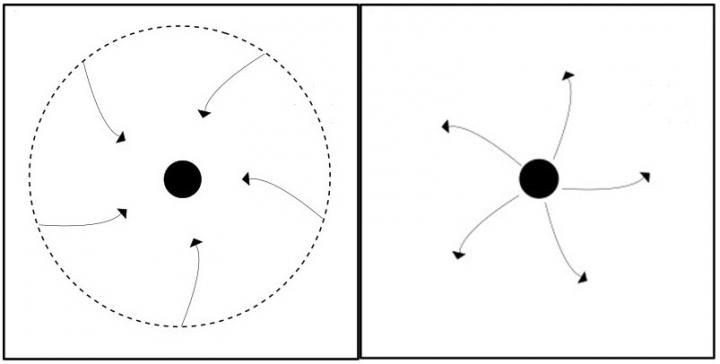Apr 21 2017
A team of scientists at the Tata Institute of Fundamental Research (TIFR), Mumbai, India, have found new ways to detect a bare or naked singularity, the most extreme object in the universe.
 A black hole (on the left) and a naked singularity (on the right). The dashed line represents the event horizon of the black hole, which is absent in the case of a naked singularity, and the arrows represent the direction in which light rays travel. In the case of the black hole, because of the presence of an event horizon, all light rays inside it necessarily end up at the singularity. However, light rays may escape from the vicinity of a naked singularity to a far away observer rendering it visible. (credit: Sudip Bhattacharyya, Pankaj Joshi)
A black hole (on the left) and a naked singularity (on the right). The dashed line represents the event horizon of the black hole, which is absent in the case of a naked singularity, and the arrows represent the direction in which light rays travel. In the case of the black hole, because of the presence of an event horizon, all light rays inside it necessarily end up at the singularity. However, light rays may escape from the vicinity of a naked singularity to a far away observer rendering it visible. (credit: Sudip Bhattacharyya, Pankaj Joshi)
When the fuel of a very massive star is spent, it collapses due to its own gravitational pull and eventually becomes a very small region of arbitrarily high matter density, that is a`Singularity', where the usual laws of physics may breakdown. If this singularity is hidden within an event horizon, which is an invisible closed surface from which nothing, not even light, can escape, then we call this object a black hole. In such a case, we cannot see the singularity and we do not need to bother about its effects. But what if the event horizon does not form? In fact, Einstein's theory of general relativity does predict such a possibility when massive stars collapse at the end of their life-cycles. In this case, we are left with the tantalizing option of observing a naked singularity.
An important question then is, how to observationally distinguish a naked singularity from a black hole. Einstein's theory predicts an interesting effect: the fabric of spacetime in the vicinity of any rotating object gets `twisted' due to this rotation. This effect causes a gyroscope spin and makes orbits of particles around these astrophysical objects precess. The TIFR team has recently argued that the rate at which a gyroscope precesses (the precession frequency), when placed around a rotating black hole or a naked singularity, could be used to identify this rotating object. Here is a simple way to describe their results. If an astronaut records a gyroscope's precession frequency at two fixed points close to the rotating object, then two possibilities can be seen: (1) the precession frequency of the gyroscope changes by an arbitrarily large amount, that is, there is a wild change in the behaviour of the gyroscope; and (2) the precession frequency changes by a small amount, in a regular well-behaved manner. For the case (1), the rotating object is a black hole, while for the case (2), it is a naked singularity.
The TIFR team, namely, Dr. Chandrachur Chakraborty, Mr. Prashant Kocherlakota, Prof. Sudip Bhattacharyya and Prof. Pankaj Joshi, in collaboration with a Polish team comprising Dr. Mandar Patil and Prof. Andrzej Krolak, has infact shown that the precession frequency of a gyroscope orbiting a black hole or a naked singularity is sensitive to the presence of an event horizon. A gyroscope circling and approaching the event horizon of a black hole from any direction behaves increasingly 'wildly,' that is, it precesses increasingly faster, without a bound. But, in the case of a naked singularity, the precession frequency becomes arbitrarily large only in the equatorial plane, but being regular in all other planes.
The TIFR team has also found that the precession of orbits of matter falling into a rotating black hole or a naked singularity can be used to distinguish these exotic objects. This is because the orbital plane precession frequency increases as the matter approaches a rotating black hole, but this frequency can decrease and even become zero for a rotating naked singularity. This finding could be used to distinguish a naked singularity from a black hole in reality, because the precession frequencies could be measured in X-ray wavelengths, as the infalling matter radiates X-rays.